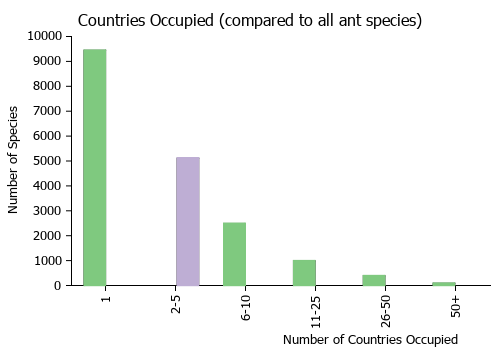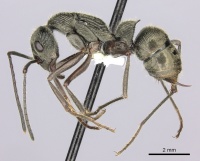Diacamma indicum
| Diacamma indicum | |
|---|---|

| |
| Scientific classification | |
| Kingdom: | Animalia |
| Phylum: | Arthropoda |
| Class: | Insecta |
| Order: | Hymenoptera |
| Family: | Formicidae |
| Subfamily: | Ponerinae |
| Tribe: | Ponerini |
| Genus: | Diacamma |
| Species: | D. indicum |
| Binomial name | |
| Diacamma indicum Santschi, 1920 | |
This species is native to the Indian subcontinent and has been introduced into southern Japan.
| At a Glance | • Gamergate • Tandem running |
Photo Gallery
Identification
Distribution
Terayama et al. (2014) name the single species known from Japan as D. indicum. This is consistent with the molecular data of Viginier et al. (2004) that suggest a human-mediated introduction from India to the Ryukyu islands, Japan.
Latitudinal Distribution Pattern
Latitudinal Range: 12.01666667° to 6.501666667°.
| North Temperate |
North Subtropical |
Tropical | South Subtropical |
South Temperate |
- Source: AntMaps
Distribution based on Regional Taxon Lists
Oriental Region: Bangladesh, India (type locality), Sri Lanka.
Palaearctic Region: Japan.
Distribution based on AntMaps
Distribution based on AntWeb specimens
Check data from AntWeb
Countries Occupied
| Number of countries occupied by this species based on AntWiki Regional Taxon Lists. In general, fewer countries occupied indicates a narrower range, while more countries indicates a more widespread species. |

|
Estimated Abundance
| Relative abundance based on number of AntMaps records per species (this species within the purple bar). Fewer records (to the left) indicates a less abundant/encountered species while more records (to the right) indicates more abundant/encountered species. |

|
Biology
Kolay and Sumana (2015) - Diacamma indicum is a primitively eusocial ponerine ant reported from the eastern and southern parts of India and Sri Lanka. Their colony size is small and varies from 20–300 monomorphic adults with a single reproductive individual. The colony size remains largely constant throughout the year and there is no drastic reduction in brood content during monsoon. Colonies of D. indicum had been reported to inhabit simple ground nests consisting of a single chamber which is connected to the exterior by a tunnel.
Investigations of their nesting behavior, especially regarding their potential adaptations to seasonal flooding, is reported in this study. Monsoons, presenting a seasonal rather than persistent flooding risk, are dealt with by occupying shallow nests and modifying the entrance with decorations and soil mounds. When nests are inundated they are evacuated and the ants occupy shelters at higher elevations. Nests were less likely to be found in the ground during monsoon season (25.6% of nests subterranean). Nests instead were found in tree trunks (25.6%), hollows of bamboo stems (18.6%), cracks in brick piles (18.6%), fallen logs (4.7%) and other opportunistic nesting sites (7%). Beyond the monsoon season, a majority of nests are subterranean (70.3% nests pre-monsoon and 82.8% post-monsoon).
Viginier et al. (2004) - D. indicum differs from previously studied Diacamma species in various ecological characteristics that are expected to result in higher dispersal rates and/or colonization abilities:
1) Even though Diacamma ants typically nest underground in open areas, D. indicum is more opportunistic with regard to its nesting preferences. We observed typical underground nests, but also nests under stones, in abandoned rice paddies, in fissures of walls in an ancient fort and even in tree branches. Related to this opportunistic nesting habit, the nests of D. indicum are generally shallow, with little signs of construction. 2) Colonies of D. indicum are small (88 ± 62 workers, N = 11) and are prone to emigrate. Nest relocation can be triggered by slight physical disturbance of the nests, whereas in the other Diacamma species from the south of India, workers retreat to the deeper chambers when the nest is disturbed. 3) D. indicum has a larger distribution area relative to other species. Indeed, D. indicum has been found in a large part of southern India and in Sri Lanka, as well as in the north (near Calcutta), whereas the other Diacamma species from the south of India appear geographically restricted to small and nonoverlapping areas. In contrast, D. indicum can be sympatric with other Diacamma species.
Diacamma indicum exhibits various life history traits (see above) suggesting higher dispersal abilities than the other Diacamma species. Only 4 of 11 microsatellites were polymorphic and only 1 had more than 4 alleles over 166 individuals originating from 7 populations from the south of India (Viginier et al. 2004). Only one mitochondrial DNA (mtDNA) haplotype was detected throughout India (including one population in the north) and Sri Lanka. Such a level of polymorphism is exceedingly low compared with other Diacamma species having much smaller ranges in the south of India. Such species exhibited strong genetic differentiation between populations separated by more than a few kilometres. We also analysed the genetic differentiation between the Indian populations and two populations from the Japanese island of Okinawa, which are morphologically similar (e.g. male genitalia, W.L. Brown unpublished monograph) and apparently belong to the same species. The genetic differentiation was high for both markers, suggesting an absence of ongoing gene flow between these populations.
Castes
Images from AntWeb
   
| |
| Syntype of Diacamma indicum. Worker. Specimen code casent0907229. Photographer Z. Lieberman, uploaded by California Academy of Sciences. | Owned by MHNG, Geneva, Switzerland. |
Nomenclature
The following information is derived from Barry Bolton's Online Catalogue of the Ants of the World.
- indicum. Diacamma rugosum var. indica Santschi, 1920g: 179 (w.) INDIA. [First available use of Diacamma rugosum r. vagans var. indicum Forel, 1903d: 400; unavailable name.] Junior synonym of vagans: Mukerjee & Ribeiro, 1925: 205. Revived from synonymy and raised to species: Doums, 1999: 1958.
Description
Karyotype
- See additional details at the Ant Chromosome Database.
 Explore: Show all Karyotype data or Search these data. See also a list of all data tables or learn how data is managed.
Explore: Show all Karyotype data or Search these data. See also a list of all data tables or learn how data is managed.
- n = 7, 2n = 14 (India) (Karnik et al., 2010; Mariano et al., 2015).
References
- Ariani, L., Yulminarti, Herwina, H., Janra, M.N., Satria, R. 2021. Ant community (Hymenoptera: Formicidae) at Ghimbo Potai Traditional Prohibited Forest, Kampar, Riau. IOP Conference Series: Earth and Environmental Science 757, 012080 (doi:10.1088/1755-1315/757/1/012080).
- Baidya, P., Bagchi, S. 2021. Influence of human land use and invasive species on beta diversity of tropical ant assemblages. Insect Conservation and Diversity, icad.12536 (doi:10.1111/icad.12536).
- Bhattacharyya, K., Annagiri, S. 2019. Characterization of nest architecture of an Indian ant Diacamma indicum (Hymenoptera: Formicidae). Journal of Insect Science 19, 9 (doi:10.1093/jisesa/iez083).
- de la Mora, A., Sankovitz, M., Purcell, J. 2020. Ants (Hymenoptera: Formicidae) as host and intruder: recent advances and future directions in the study of exploitative strategies. Myrmecological News 30: 53-71 (doi:10.25849/MYRMECOL.NEWS_030:053).
- Dias, R.K.S., Rajapaksa, R.P.K.C. 2017. Geographic records of subfamilies, genera and species of ants (Hymenoptera: Formicidae) in the four climatic zones of Sri Lanka: A review. Journal of Science of the University of Kelaniya Sri Lanka 11, 23-45. (doi:10.4038/josuk.v11i2.7999).
- Doums, C. 1999. Characterization of microsatellite loci in the queenless ponerine ant Diacamma cyaneiventre. Mol. Ecol. 13: 1957-1959 (page 1958, Raised to species)
- Fujioka, H., Okada, Y. 2019. Liquid exchange via stomodeal trophallaxis in the ponerine ant Diacamma sp. from Japan. Journal of Ethology 37, 371–375 (doi:10.1007/S10164-019-00602-9).
- KARNIK et al., 2010. Karyotype instability in the ponerine ant genus Diacamma. Journal of Genetics, Vol. 89, No. 2.
- Kaur, R., Anoop, K., Sumana, A., 2012. Leaders follow leaders to reunite the colony: relocation dynamics of an Indian queenless ant in its natural habitat, Animal Behaviour, 83, 1345-1353 (dx.doi.org/10.1016/j.anbehav.2012.02.022).
- Kaur, R., Joseph, J., Anoop, K., Sumana, A. 2017. Characterization of recruitment through tandem running in an Indian queenless ant Diacamma indicum. Royal Society Open Science 41, 160476 (doi:10.1098/rsos.160476).
- Kolay, S. and S. Annagiri. 2015. Dual response to nest flooding during monsoon in an Indian ant. Scientific Reports. 5. doi:10.1038/srep13716
- Mariano, C.S.F., Santos, I.S., Silva, J.G., Costa, M.A., Pompolo, S.G. 2015. Citogenética e evolução do cariótipo em formigas poneromorfas. In: Delabie, J.H.C., Feitosa, R.M., Serrao, J.E., Mariano, C.S.F., Majer, J.D. (eds) As formigas poneromorfas do Brasil, 1st edn. Ilhéus, Brasil, pp 102–125 (doi:10.7476/9788574554419.0010).
- Mizumoto, N., Tanaka, Y., Valentini, G., Richardson, T. O., Annagiri, S., Pratt, S. C., Shimoji, H. 2023. Functional and mechanistic diversity in ant tandem communication. IScience 26(4), 106418 (doi:10.1016/j.isci.2023.106418).
- Mukerjee, D.; Ribeiro, S. 1925. On a collection of ants (Formicidae) from the Andaman Islands. Rec. Indian Mus. 27: 205-209 (page 205, Junior synonym of vagans)
- Peeters, C. & K. Tsuji 1993. Reproductive conflict among ant workers in Diacamma sp. from Japan: dominance and oviposition in the absence of the gamergate. Insectes Soc., 40: 119-136.
- Rocha, F.H., Lachaud, J.-P., Hénaut, Y., Pozo, C., Pérez-Lachaud, G. 2020. Nest site selection during colony relocation in Yucatan Peninsula populations of the ponerine ants Neoponera villosa (Hymenoptera: Formicidae). Insects 11, 200 (doi:10.3390/insects11030200).
- Santschi, F. 1920g. Cinq nouvelles notes sur les fourmis. Bull. Soc. Vaudoise Sci. Nat. 53: 163-186 (page 179, worker described)
- Shimoji, H., Kasutani, N., Ogawa, S., Hojo, M.K. 2020. Worker propensity affects flexible task reversion in an ant. Behavioral Ecology and Sociobiology 74 (doi:10.1007/S00265-020-02876-3).
- Silva, J. P., Valadares, L., Vieira, M. E. L., Teseo, S., Châline, N. 2021. Tandem running by foraging Pachycondyla striata workers in field conditions vary in response to food type, food distance, and environmental conditions. Current Zoology 67(5), 541–549 (doi:10.1093/cz/zoab050).
- Subedi, I.P., Budha, P.B., Bharti, H., Alonso, L., Yamane, S. 2023. Ponerine ants of Nepal (Hymenoptera: Formicidae, Ponerinae): a generic synopsis, new faunal records, and rediscovery of a rare ant, Emeryopone franzi (Baroni Urbani 1975). (doi:10.20362/am.016003).
- Terayama, M., Kubota, S. & Eguchi, K. 2014. Encyclopedia of Japanese ants (in japanese). ISBN9784254171563
- Tsuji, K., C. Peeters & B. Hölldobler 1998. Experimental investigation of the mechanism of reproductive differentiation in the queenless ant, Diacamma sp. from Japan. Ethology 104: 633-643.
- Viginier, B., Peeters, C., Brazier, L. & Doums, C. 2004. Very low genetic variability in the Indian queenless ant Diacamma indicum. Molecular Ecology 13: 2095-2100.
References based on Global Ant Biodiversity Informatics
- Chapman, J. W., and Capco, S. R. 1951. Check list of the ants (Hymenoptera: Formicidae) of Asia. Monogr. Inst. Sci. Technol. Manila 1: 1-327
- Dias R. K. S., H. P. G. R. C. Ruchirani, K. R. K. A. Kosgamage, and H. A. W. S. Peiris. 2013. Frequency of nest occurrence and nest density of Aneuretus simoni Emery (Sri Lankan Relict Ant) and other ant fauna in an abandoned rubber plantation (Kirikanda Forest) in southwest Sri Lanka. Asian Myrmecology 5: 59-67.
- Emery C. 1911. Hymenoptera. Fam. Formicidae. Subfam. Ponerinae. Genera Insectorum 118: 1-125.
- Forel A. 1903. Les fourmis des îles Andamans et Nicobares. Rapports de cette faune avec ses voisines. Rev. Suisse Zool. 11: 399-411.
- Forel A. 1911. Ameisen aus Ceylon, gesammelt von Prof. K. Escherich (einige von Prof. E. Bugnion). Pp. 215-228 in: Escherich, K. Termitenleben auf Ceylon. Jena: Gustav Fischer, xxxii + 262 pp.
- Forel, A. 1908. Fourmis de Ceylan et d'Égypte récoltées par le Prof. E. Bugnion. Lasius carniolicus. Fourmis de Kerguelen. Pseudandrie? Strongylognathus testaceus. Bull. Soc. Vaudoise Sci. Nat. 44: 1-22
- Terayama M., S. Kubota, and K. Eguchi. 2014. Encyclopedia of Japanese ants. Asakura Shoten: Tokyo, 278 pp.
- Viginier B., C. Peeters, L. Brazier, and C. Doums. 2004. Very low genetic variability in the Indian queenless ant Diacamma indicum. Molecular Biology 13: 2095-2100.
- Yamane S. 2016. How many species of Ants in Amami Islands? (in Japanese). Part 2, chapter 1 in How many species of Ants in Amami Islands? Pp. 92-132.


